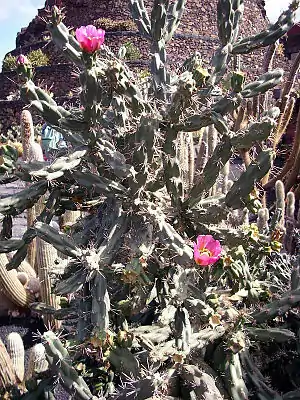Cylindropuntia imbricata
Cylindropuntia imbricata ist eine Pflanzenart aus der Gattung der zylindrischen Feigenkakteen (Cylindropuntia) in der Familie der Kakteengewächse (Cactaceae). Das Artepitheton imbricata bedeutet dachziegelförmig. Fremdsprachige Trivialnamen sind „Abrojo“, „Candelabrum Cactus“, „Cane Cactus“, „Cane Cholla“, „Cardenche“, „Cardón“, „Coyonostle“, „Joconostle“, „Tesajo“, „Tesajo“, „Tesajo Macho“, „Tree Cholla“, „Vela de Coyote“ und „Xoconostle“.
| Cylindropuntia imbricata | ||||||||||||
|---|---|---|---|---|---|---|---|---|---|---|---|---|

Cylindropuntia imbricata | ||||||||||||
| Systematik | ||||||||||||
| ||||||||||||
| Wissenschaftlicher Name | ||||||||||||
| Cylindropuntia imbricata | ||||||||||||
| (Haw.) F.M.Knuth |

Beschreibung
Cylindropuntia imbricata wächst baumartig bis zu 3 Meter und mehr hoch werdend und bildet im Alter oft einen holzigen Stamm aus. Die Zweige stehen schräg auseinander, oft aufwärts gerichtet. Die stark gehöckerten Endglieder sind etwa 2 bis 3 Zentimeter lang. Die Höcker selbst sind 2 bis 2,5 Zentimeter lang und seitlich abgeflacht. Die 8 bis 30 Dornen werden bis zu 3 Zentimeter lang. Sie sind braun mit dünnen Scheiden.
Die 4 bis 6 Zentimeter langen und bis zu 9 Zentimeter breiten, dunkelrosa bis magenta oder rötlich magenta gefärbten Blüten erscheinen an den zylindrischen bis keulenförmigen Triebenden. Die ebenfalls stark gehöckerten Früchte sind 2 bis 4,5 Zentimeter lang, verkehrt eiförmig, dornenlos und gelb. Sie erreichen Durchmesser zwischen 2 und 4 Zentimeter.
Verbreitung, Systematik und Gefährdung
Cylindropuntia imbricata ist in den US-Bundesstaaten Arizona, Colorado, Texas, Oklahoma und New Mexico sowie in der gesamten Mitte Mexikos beheimatet. Im Südwesten Kansas ist die Art winterhart. Cylindropuntia imbricata gehört heute zu den bereits in Europa wild lebenden Kakteen. In der Schweiz und Frankreich sind gelegentliche Bestände vorhanden, während die Art in Spanien bereits als etabliert gilt.[1] In Südafrika wurde sie zu Beginn des 20. Jahrhunderts eingeführt und ist mit Ausnahme der Provinz Natal im ganzen Land verbreitet. Cylindropuntia imbricata gehört dort zu den Kakteenarten, die als Unkräuter biologisch bekämpft werden.[2]
Die Erstbeschreibung erfolgte als Cereus imbricatus und wurde 1821 von Adrian Hardy Haworth veröffentlicht.[3] Frederik Marcus Knuth stellte die Art 1936 in die Gattung Cylindropuntia.[4]
Es werden folgende Unterarten unterschieden:[5]
- Cylindropuntia imbricata subsp. imbricata
- Cylindropuntia imbricata subsp. argentea (M.S.Anthony) U.Guzmán
- Cylindropuntia imbricata subsp. cardenche (Griffiths) U.Guzmán
- Cylindropuntia imbricata subsp. lloydii (Rose) U.Guzmán
- Cylindropuntia imbricata subsp. rosea (DC.) M.A.Baker
- Cylindropuntia imbricata subsp. spinosior (Engelm.) M.A.Baker, Cloud-H. & Majure
- Cylindropuntia imbricata subsp. spinotecta (Griffiths) M.A.Baker
In der Roten Liste gefährdeter Arten der IUCN wird die Art als „Least Concern (LC)“, d. h. als nicht gefährdet geführt.[6]
Nachweise
Literatur
- Edward F. Anderson: Das große Kakteen-Lexikon. 2. Auflage. Eugen Ulmer KG, Stuttgart 2011, ISBN 978-3-8001-5964-2, S. 172.
- Alwin Berger: Kakteen – Anleitung zur Kultur und Kenntnis der wichtigsten eingeführten Arten. Eugen Ulmer, Stuttgart 1929, S. 62.
- N. L. Britton, J. N. Rose: The Cactaceae. Descriptions and Illustrations of Plants of the Cactus Family. Band I. The Carnegie Institution of Washington, Washington 1923, S. 63 ff. (online).
- Franz Essl, Johannes Kobler: Spiny invaders – Patterns and determinants of cacti invasion in Europe. In: Flora – Morphology, Distribution, Functional Ecology of Plants. Band 204, Nummer 7, 2009, S. 485–494 (doi:10.1016/j.flora.2008.06.002).
- William Jackson Hooker: Curtis´s Botanical Magazine. Vol. XV. Royal Botanic Garden of Kew, London 1842, S. 299–301.
- Brian Loflin, Shirley Loflin: Texas Cacti. TAMU nature guide, 2009, ISBN 1-60344-108-5, S. 65.
- V. C. Moran, H. G. Zimmermann: Biological control of cactus weeds of minor importance in South Africa. In: Agriculture, Ecosystems & Environment. Band 37, Nummer 1–3, 1991, S. 37–55 (doi:10.1016/0167-8809(91)90138-N).
- Karl Schumann: Gesamtbeschreibung der Kakteen (Monographia cactacearum). J. Neumann, Neudamm 1899, S. 668 (online).
Einzelnachweise
- Franz Essl, Johannes Kobler: Spiny invaders – Patterns and determinants of cacti invasion in Europe. 2009, S. 488.
- V. C. Moran, H. G. Zimmermann: Biological control of cactus weeds of minor importance in South Africa. 1991, S. 42–44.
- Adrian Hardy Haworth: Revisiones Plantarum Succulentarum. London 1821, S. 70 (online).
- Curt Backeberg, Frederik Marcus Knuth: Kaktus-ABC. En haandbog for fagfolk og amatører. Kopenhagen 1936, S. 125.
- Nadja Korotkova, David Aquino, Salvador Arias, Urs Eggli, Alan Franck, Carlos Gómez-Hinostrosa, Pablo C. Guerrero, Héctor M. Hernández, Andreas Kohlbecker, Matias Köhler, Katja Luther, Lucas C. Majure, Andreas Müller, Detlev Metzing, Reto Nyffeler, Daniel Sánchez, Boris Schlumpberger, Walter G. Berendsohn: Cactaceae at Caryophyllales.org – a dynamic online species-level taxonomic backbone for the family – Electronic supplement. In: Willdenowia. Band 51, Nr. 2, 2021, S. 75–76 (doi:10.3372/wi.51.51208).
- Cylindropuntia imbricata in der Roten Liste gefährdeter Arten der IUCN 2014.1. Eingestellt von: Hernández, H.M., Cházaro, M. & Gómez-Hinostrosa, C., 2013. Abgerufen am 12. Juni 2014.